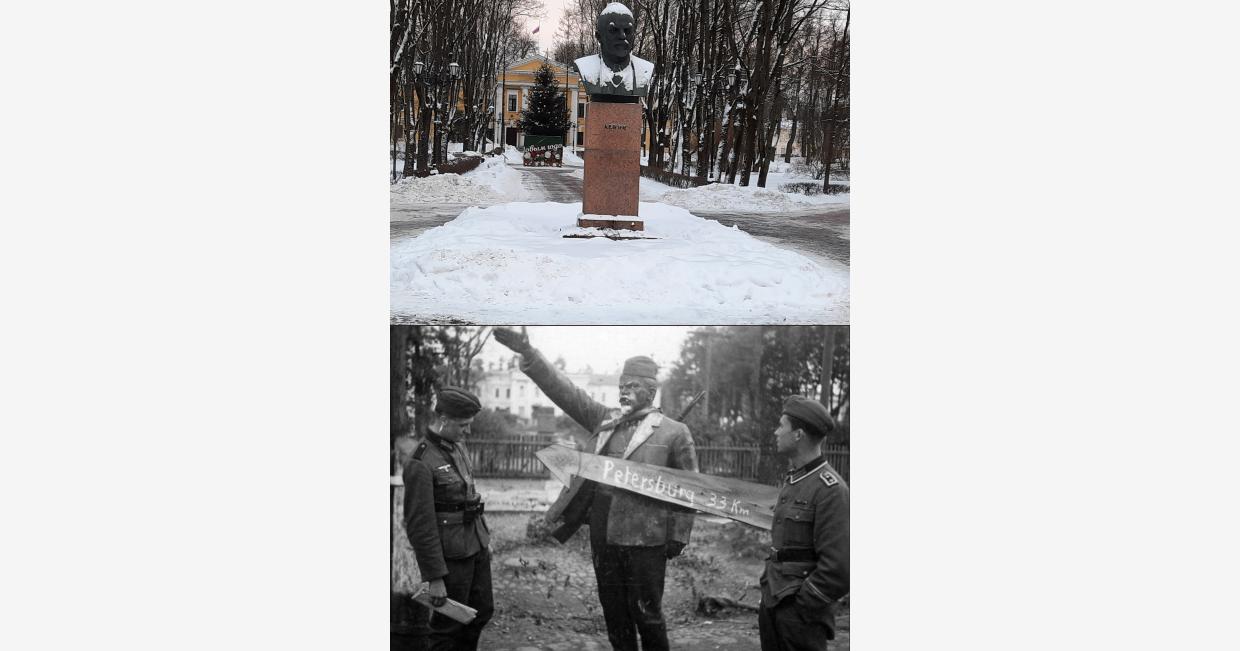Prospekt of the 25th of October, Gatchina. February 2022 / Petersburgerstrasse, Lindemannstadt. October 1941
German soldiers examine a dethroned and defaced statue of Lenin on the Prospekt of the 25th of October (renamed to Petersburgerstrasse). In two years, the largest German cemetery in the town would be located right in front of the historic hospital building, which is visible in the background of the photo.
From the memoirs of Wilhelm Lubbecke, 58.Infanterie-Division:
"Most of the time we entertained ourselves, but the army provided occasional recreational activities for us behind the lines. Perhaps every six months, we would even be given a day off from frontline duty, depending on the situation. The main center for recreation in the Leningrad area was Krasnogvardeisk. Though the small city was located just 10 or 15 miles south of Uritsk [southwestern suburb of Leningrad, now a district of St. Petersburg, where the distance from the frontline to the city center was the shortest - only 13 kilometers to the Winter Palace as the crow flies - Alexander Shmidke], I visited it only once for about 24 hours.
While the army organized soccer matches or other sporting events in Krasnogvardeisk where teams from different units would compete, many personnel from all services sought out the temporary companionship of females during their leaves. To meet this need, the army did not establish brothels, but it did bring in German women as "entertainment troops." According to rumour, the Luftwaffe was purported to operate two Junkers transports filled with women from occupied Europe who flew on a regular circuit of its bases to visit the pilots. Not interested in pursuing such liaisons during my visit to Krasnogvardeisk, I instead visited the German cemetery and a local theater presenting comedy routines and musical performances. [There were at least 2 brothels in Krasnogvardeisk, originally staffed with women from Baltic states and then local women who were willing to take up such job in order not to die of starvation - Alexander Shmidke]"
According to the numbers provided by the Director of the State Archive of the Leningrad Province Julia Kripatova, 140 000 civilians were killed or died of hunger and exposure and 250 000 more were deported to concentration camps or to forced labour in Germany. Of the latter number, it is unclear how many returned. Total German WIA and KIA casualties over the course of the Battle for Leningrad from July 1941 to August 1944 are around 600 000 men, while the Red Army suffered around 3 000 000 total casualties.

![ Image German cemetery hospital building German cemetery in front of the hospital (now town hall) building. 1943/2022 [Click and drag to move] Image German cemetery hospital building German cemetery in front of the hospital (now town hall) building](/sites/default/files/styles/vertical/public/articles/GridArt_20220102_194850152_0.jpg?itok=aZsKw3oS)